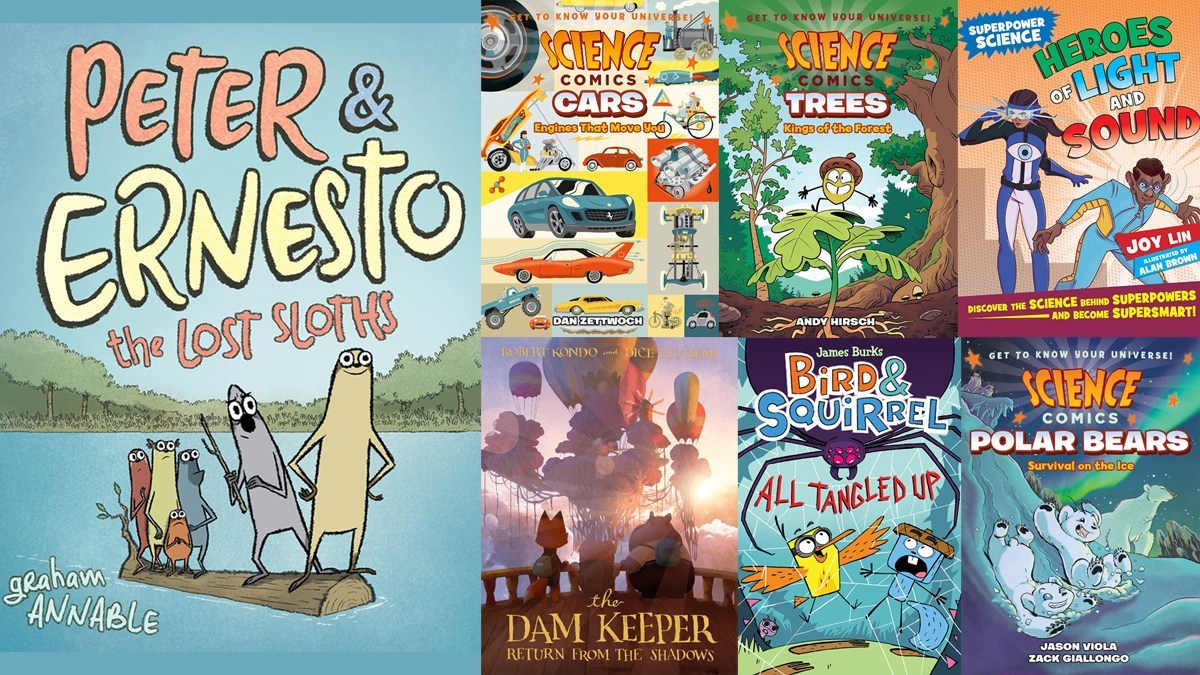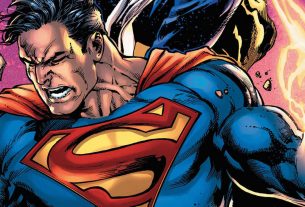Last week’s Stack Overflow was all about comics, and this week I’m continuing that trend because I have even more comics that I just didn’t have time to cover in one column.
Peter & Ernesto: The Lost Sloths by Graham Annable
This is a follow-up to last year’s Peter & Ernesto (covered in this Stack Overflow), about two sloth friends: one who is adventurous and curious (Ernesto), and one who is timid and just likes to stay in his tree (Peter). At the start of this book, however, staying in the tree isn’t an option—a hurricane sweeps through and destroys their home, leaving the two of them (and their other sloth friends) with only one option: find a new tree. The band of sloths has another adventure, encountering armadillos and peccaries and snakes and bats (some friendly, some not-so-friendly), on their quest to find a new home. What I particularly liked about this book is that both Ernesto’s adventurous spirit and Peter’s cautious preparation are rewarded: they make a good team, and it’s not just about getting Peter to change into another version of Ernesto.
Bird & Squirrel: All Tangled Up by James Burks
Speaking of odd couples, Bird and Squirrel are also an adventurous-cautious pairing. This is the fourth book in the series; this time Squirrel’s daughter Birdie is along for the adventure. Well, she’s supposed to be at home with Squirrel, but (like her namesake) she’s also excited to get out and explore—to find the mysterious Bigfoot. The humor in the books largely comes from the relationship between Bird and Squirrel, but usually Bird is carefree and spontaneous—and only manages to survive through dumb luck. Squirrel, on the other hand, is afraid of everything and overprepares for everything, but he’s portrayed as a worrywart and a stick-in-the-mud. But they always manage to learn valuable lessons from each other: in this case, there are times when even Bird realizes he needs to exercise some caution, and Squirrel really steps up when the stakes are high. Oh, and there’s also some really weird subplot about Squirrel’s dream involving a talking flower.
Superpower Science: Heroes of Light and Sound by Joy Lin, illustrated by Alan Brown
This book is part of a series that looks into the science behind superhero powers, and this particular volume is about light and sound. Specifically, it takes a look at the powers of invisibility, x-ray vision, super hearing, eye lasers, and sonic blasts. After a brief explanation of how our eyes and ears work, the rest of the book introduces superheroes … and then debunks their powers by explaining how difficult (or impossible) they would be to use in real life. For instance, being invisible would also involve being naked and really, really quiet—and if you happened to get dirty or collect any dust, then you’d start to be visible anyway. Plus, having see-through eyes would make you blind, as well!
Okay, so the superhero world may not be quite as entertaining if they were only allowed to have scientifically accurate powers, and my daughter remarked that this book was trying to take the fun out of superheroes. I think you can know why certain powers are impossible but still enjoy comics anyway, and the way that the difficulties are illustrated in Superpower Science is pretty entertaining in itself. Other books in the series deal with force and motion, matter, and the human body.
Cars: Engines That Move You by Dan Zettwoch
Polar Bears: Survival on the Ice by Jason Viola and Zack Giallongo
Trees: Kings of the Forest by Andy Hirsch
Okay, while we’re on the subject of real science, here are a couple new titles from First Second’s Science Comics series!
Cars is about the science and history of cars, in a format that parallels the four-stroke combustion engine: intake, compression, power, and exhaust. It’s a fast-paced trip through early vehicles to early engines to modern-day cars, with plenty of “firsts,” world records, and lots of failures, too. As somebody who doesn’t know much about vehicles, I found it really informative, and also entertaining. The only thing that bugged me is that Dan Zettwoch loves to draw bug-eyed characters, perhaps as a reference to hot rodders (specifically Ed “Big Daddy” Roth’s cartoons), but you’d just see random characters with eyeballs hanging out, which didn’t really have anything to do with the narrative.
Polar Bears is told from the point of view of a small family of polar bears: a mother and two cubs. The mother is teaching the cubs how things work, from identifying types of ice to catching and eating a seal to fighting and romance. There’s also a section about the shrinking pack ice and its effect on polar bears, along with some ways that humans can protect their habitat.
Finally, Trees is an in-depth look at—you guessed it—trees! Our guide in this book is a lively acorn, who just wants to get out and find some excitement instead of sitting around and waiting to become a tree. But then he gets a series of visits from more experienced minds: a frog, a leaf, a squirrel (!), even some fungus, who all explain how trees grow and what they do for the forest. There’s a lot in this book that I remember from grade school, but I also learned some new things: like why palm trees aren’t actually wood, how roots change directions while growing, and—my favorite—how forests communicate with each other through the mycorrhizal network.
I continue to be impressed with the way that Science Comics make various subjects approachable and entertaining.
The Dam Keeper 3: Return from the Shadows by Robert Kondo and Dice Tsutsumi
This third and final volume in the Dam Keeper series. I wrote about the first two books in this Stack Overflow column. We pick up the story with Pig and his friends far from home, anticipating that the next wave of dangerous fog will be hitting their hometown soon. But Pig is on the trail of some strange rumors that he thinks will lead him to his father, who left into the fog and never returned. What he finds, after climbing up onto a floating island, is something amazing that may help his home, but forces him to make some difficult decisions. The illustrations in this series (based on a short film) are beautiful, and the story is poignant and moving. It’s about growing up and taking responsibility, and about trusting in your friends, and about letting go.
My Current Stack
I mentioned last week that I’d bought a copy of One Hundred, Ten, and One, a collection of microfiction by O. Westin, to read while I went to Gen Con. Well, as it turns out I read the entire thing on the plane there, because reading it was a bit like eating popcorn: you don’t realize how much you’ve had until the entire bowl is empty. I did enjoy most of it—it’s a mix of sci-fi, fantasy, and horror, but in bite-sized 140-character chunks (with the occasional longer story). The stories are wide-ranging and diverse, with some that you could read to your kids and others that were definitely written with an adult audience in mind, but the constraints of the format means that the introduction, conflict, climax, and resolution are all crashed together. What I found was that a lot of the stories relied on gender stereotypes for their punchlines: the surprise was that the soldiers were women, or the main character was a woman instead of a man, or something like that. Those stories stuck out to me, perhaps because it felt like they wouldn’t be as interesting in a world where women and girls weren’t assumed to play out certain roles; or perhaps because those stories still work, because those gender expectations are still largely in place.
I’m also about halfway through reading So You Want to Talk About Race? by Ijeoma Oluo and it’s been a powerful read. Oluo addresses things like privilege (white and otherwise), the contrasting experiences that different communities have when it comes to police, and intersectionality, all in a way that is easy to understand even if you’re unfamiliar with what all these terms mean—though not necessarily always easy to stomach. I think it’ll be a book that I’ll end up recommending often, because it gives people the tools and language to have conversations about race, which can often be a barrier to even starting those necessary conversations.
I got hit with con crud on returning from Gen Con, so I’ve spent the past week holed up and coughing a lot, which was no fun. I’m hoping I’ve turned the corner on that, so I’m hoping I’ll be able to get back to being productive soon! My Stack Overflows may be a little light for the next few weeks, though, because I’ve got a lot of board games to get through…
Disclosure: I received review copies of the comics reviewed in this column.









